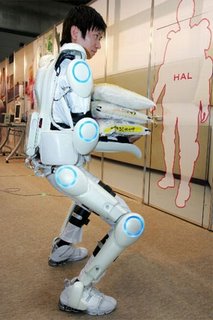I have always thought that "cybernetic" technologies would provide for people with spinal injuries long before stem cell therapies. Japan's Yoshiyuki Sankai, a professor and engineer at Tsukaba University developed the "HAL" project. HAL stands for hybrid assisted limb, and detects muscle movement through electrical signals on the skin and amplifies them. read more
Two control systems interact to help the wearer stand, walk and climb stairs. A "bio-cybernic" system uses bioelectric sensors attached to the skin on the legs to monitor signals transmitted from the brain to the muscles. It can do this because when someone intends to stand or walk, the nerve signal to the muscles generates a detectable electric current on the skin's surface. These currents are picked up by the sensors and sent to the computer, which translates the nerve signals into signals of its own for controlling electric motors at the hips and knees of the exoskeleton. It takes a fraction of a second for the motors to respond accordingly, and in fact they respond fractionally faster to the original signal from the brain than the wearer's muscles do.
Homepage of the "HAL" suit.
Here is a page of other "exoskeletons" a wikipedia about "cybernetics"

